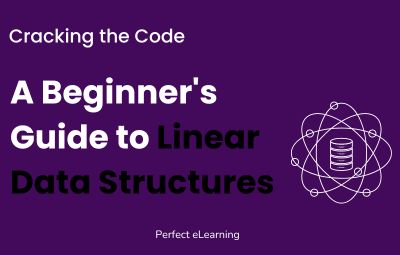Cracking the Code: A Beginner's Guide to Linear Data Structures
 Perfect eLearning
Perfect eLearningUnlock the secrets of linear data structures with this beginner's guide, Cracking the Code. Learn foundational concepts and techniques.
Introduction
Embarking on the journey of coding often feels like stepping into a labyrinth of complexities. However, understanding the fundamentals is crucial, and when it comes to data structures, linear data structures play a pivotal role.
1. Decoding Linear Data Structures
Linear data structures are the building blocks of many algorithms and programs. Simply put, they organize and store data in a linear order. If you're just starting, don't be intimidated; we'll break it down into manageable parts.
2. The Foundation: Arrays
Arrays serve as the foundation of linear data structures. They are collections of elements, each identified by an index or a key. Arrays provide a straightforward way to store and access data, making them an essential concept for beginners.
3. Linking the Pieces: Linked Lists
Linked lists take a different approach by connecting elements through pointers. This flexibility comes in handy when dealing with dynamic data. Picture it as a chain where each link knows about its neighbor, offering more versatility compared to arrays.
4. Stacking Up: Understanding Stacks
Imagine a stack of plates – the last one you place is the first one you pick up. That's the Last In, First Out (LIFO) principle of stacks. They're used in scenarios where the order of data retrieval is crucial, such as managing function calls or processing expressions.
5. Queuing In: Exploring Queues
On the flip side, queues operate on the First In, First Out (FIFO) principle. Picture it like waiting in a line – the person who arrived first gets served first.
6. Unraveling the Complexity: Time and Space Complexity
Understanding time and space complexity is essential for optimizing your code. Linear data structures, depending on their type, can influence the efficiency of your algorithms.
7. Cracking the Code: Implementing Linear Data Structures
Now, let's get our hands dirty with some coding. Implementing linear data structures involves translating theoretical knowledge into practical solutions. We'll walk through examples and share tips to help you navigate the coding landscape.
8. Mastering the Art: Advanced Linear Data Structure Concepts
As you progress, you'll encounter more advanced concepts like trees and graphs, which are extensions of linear data structures. These offer additional layers of complexity but also open up new possibilities for solving intricate problems.
9. Choosing Wisely: When to Use Which
Selecting the right data structure is like choosing the right tool for a task. We'll provide guidelines to help you decide when to use arrays, linked lists, stacks, or queues based on the specific requirements of your project.
10. Breaking it Down: Simple Linear Data Structure Projects
To solidify your understanding, we've curated some engaging projects. These hands-on exercises will allow you to apply what you've learned and gain confidence in using linear data structures.
Conclusion
In conclusion, cracking the code on linear data structures is a rewarding endeavor. Whether you're building a simple program or tackling complex algorithms, a solid understanding of arrays, linked lists, stacks, and queues is your key to success.
Frequently Asked Questions (FAQs)
Q1. What are the main advantages of using arrays?
A1: Arrays provide constant-time access to elements, making them efficient for random access.
Q2. Can you provide a real-world example where a linked list is beneficial?
A2: Consider a music playlist; linked lists allow easy insertion and removal of songs without restructuring the entire playlist.
Q3. How does the LIFO principle apply to stacks?
A3: LIFO means the last item added is the first one removed, making stacks ideal for managing function calls and storing temporary data.
Q4. What scenarios favor the use of queues over other data structures?
A4: Queues are useful in scenarios where maintaining order is critical, such as in print job scheduling or handling requests in a web server
Q5. Are there any drawbacks to using linear data structures extensively?
A5: Linear data structures may have limitations in handling dynamic data or complex relationships, so it's crucial to choose the right structure for each situation.

Subscribe to my newsletter
Read articles from Perfect eLearning directly inside your inbox. Subscribe to the newsletter, and don't miss out.
Written by

Perfect eLearning
Perfect eLearning
Perfect eLearning is providing you amazing IT courses with Live Projects, Learn now and Pay later option and 100% Placement Guarantee.